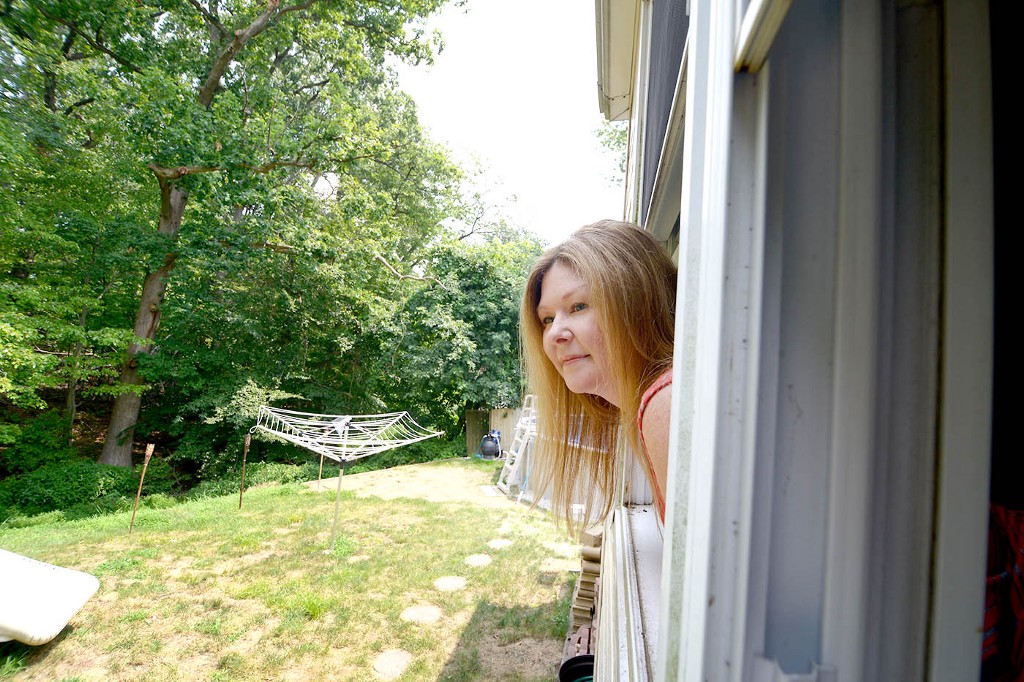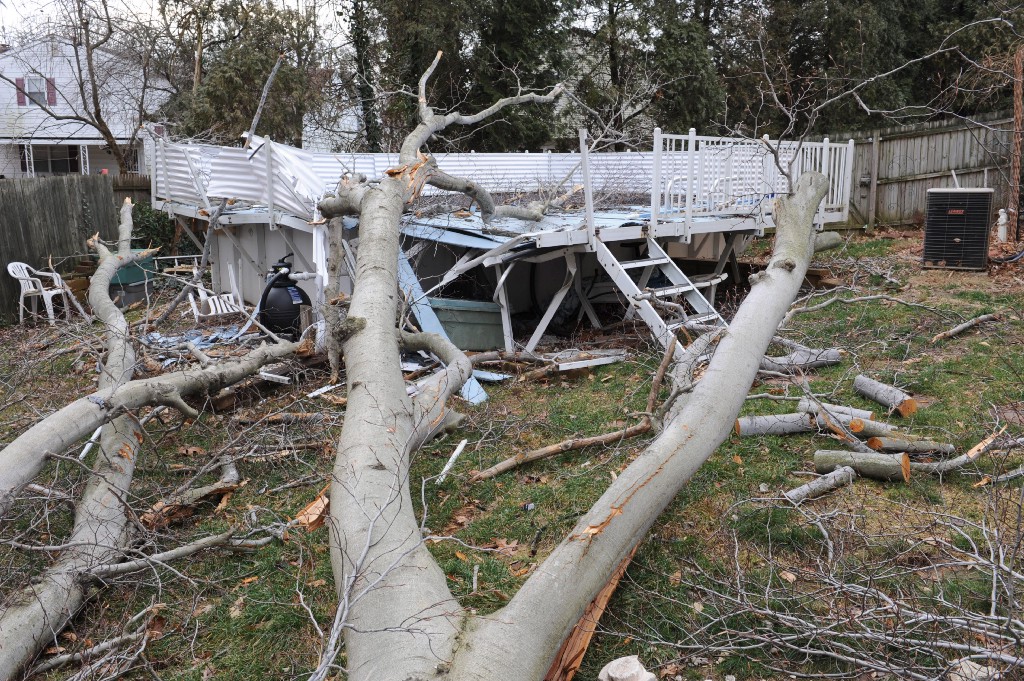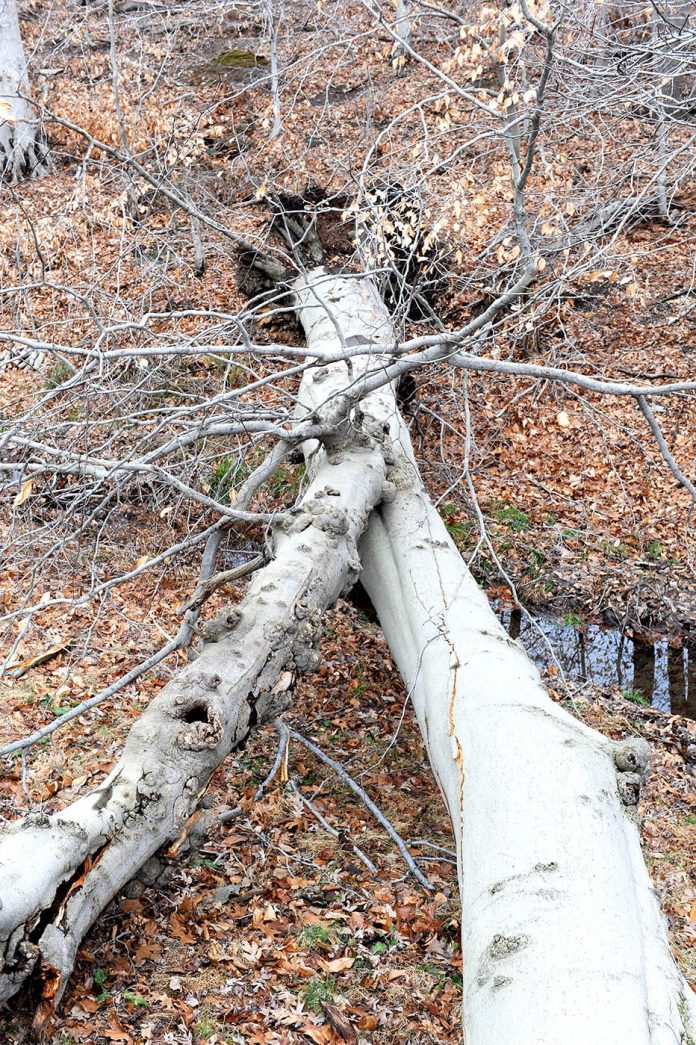Large branches of another tree outside Christine Ostrowski’s Kismet Terrace home fell into the woods while her kids were playing outside nearby. MARIA POUCHNIKOVA / TIMES PHOTOS
Christine Ostrowski looks out her kitchen window and worries.
The view is nice enough, even tranquil. The backyard of Ostrowski’s Pine Valley home drops down to Ballard Brook and slopes up again in ground covered with grand old trees.
It’s the trees that concern her. And Ostrowski’s concerns might be shared by any homeowners who have trees on or near their properties.
Ostrowski has good reason for uneasiness. When Superstorm Sandy hit in October 2012, its winds blew down a 30-foot-tall beech. The tree missed the Ostrowski home when it crashed across the creek, and nobody was hurt. But the beech creamed the family’s above-ground pool.
That’s not all. Outside her Kismet Terrace home, Ostrowski pointed to large branches of another tree that Sandy had damaged. Well after the storm, they had fallen into the woods. Again, no one was hurt, and that time, there was no property damage.
Still …
“My kids were outside playing,” she said in a July 17 interview.
She now is so concerned about trees falling onto her house that she has her children sleep in the basement during windy storms.
OUT ON A LIMB?
Ostrowski and her husband, Stephen, learned plenty when Sandy caused damage on their and their neighbors’ properties.
The first thing they found out is what their insurance company covered.
“They were great,” she said of her insurer’s adjusters. The coverage was good.
The tree that crushed the family pool was removed. The pool was replaced. Yes, the family took some loss, Ostrowski said, but most of her repairs were covered.
Since the tree did not hit the family home, she said, the Ostrowskis’ home insurance would not have covered removing it, she found out.
“The tree had to hit a structure,” she said. “The pool — because it had running water and electricity — is considered a structure.” If the tree had hit a shed that had neither water nor power, the loss would not have been covered, she said.
“If a tree hits a home or other insured structure, such as a detached garage, standard homeowners insurance policies provide coverage for the damage the tree does to the structure and the contents within it,” Loretta L. Worters, vice president of the Insurance Information Institute, wrote in a July 18 email to the Northeast Times. “This includes trees felled not only by a windstorm or hail, but also winter-related disasters caused by the weight of ice, snow or sleet.”
And, it doesn’t matter, Worters wrote, that it’s your tree or a neighbor’s that falls onto your property.
“If it landed on your house, you should file a claim with your insurance company,” she stated.
“Trees, shrubs and branches can become projectiles capable of traveling significant distances and can cause considerable damage to property during an intense windstorm such as a hurricane, tropical storm or tornado,” she continued. “In most cases, an insurance company is not going to spend time trying to figure out where a tree, shrub or branch originally came from.”
Then, there’s the matter of paying for tree removal and property repairs.
Ostrowski said the tree that hit her pool was cut up and removed. A neighbor, she said, paid much more for a fallen tree to be removed and then the workers didn’t haul away most of it.
Worters suggested that homeowners look at their insurance policies and talk to their agents about what specifically is covered.
For standard policies, an insurer will cover tree removal costs from about $500 to $1,000 if a tree hits an insured structure, Worters wrote.
“There is generally no coverage for removal of trees and branches that may simply fall in your yard,” she stated. “However, some insurance companies may pay for the cost of removing the felled tree if it is blocking a driveway or a ramp designed to assist the handicapped.”
Standard home insurance policies provide coverage for damage to trees and shrubs due to fire, lightning, explosion, theft, vandalism, malicious mischief and damage cause by aircraft and vehicles not owned by the resident, Worters wrote.
Such coverage, she stated, is generally limited to up to 5 percent of the amount of insurance on the structure of the house.
Optional comprehensive portions of standard auto insurance policies cover cars that are damaged or destroyed by falling trees, Worters said. Seventy-seven percent of all American auto insurance policyholders have comprehensive coverage, according to Worters.
LOOKING FOR TROUBLE
Pointing to a tall tree leaning slightly across the creek, Ostrowski said she wonders whether she should have it removed now.
It’s expensive, she said.
And, according to Samantha Phillips, the city’s deputy managing director for emergency management, trees on private property are the responsibility of property owners.
“Preventative maintenance is a good way to minimize the potential for weaker or dead limbs to come loose or fall during a storm,” she stated in an email to the Northeast Times.
A homeowner can eyeball a tree to see if something is wrong, said Steve Goin, an arborist with Bartlett Tree Experts in Bala Cynwyd.
There could be trouble with trees that have no leaves during the season, carpenter ant infestations, woodpecker holes or cavities, he said. Bark that looks degraded or is falling off is another indicator. Double-stemmed trees have a tendency to crack, Goin said in a July 18 phone interview.
If a homeowner sees any of those signs, he said, it’s time to call in tree-care pros.
Better still is to have an arborist check trees on a regular basis.
When Sandy hit, Goin said, many trees were pulled out of the ground from the roots up. He said he saw a lot of black locust trees destroyed that way.
The tulip poplar is another tree that is prone to be knocked down during a storm, Goin said. That tree also is the one most frequently hit by lightning, he said.
Norway maples were commonly planted along city streets, Goin said, and Sandy felled many of them in Northeast Philly.
“They kind of split,” he said.
Homeowners shouldn’t just cut down trees, Goin said, without considering the benefits they offer. They provide plenty of shade and prevent much rainfall from flowing into and flooding waterways. ••
Tree lines
Insurance Information Institute, www.iii.org
The institute has an “Understanding trees and insurance” podcast in English and Spanish available at http://www2.iii.org/videos/ and on iTunes by typing “Insurance Information Institute” into the search field.
Bartlett Tree Experts, 610–664–3200, www.bartlett.com
A previous Northeast Times article on hurricane preparedness at http://www.northeasttimes.com/2013/jun/19/weathering-storm/#.UehLWNKyC94

Danger looming: Christine Ostrowski looks out her back window into an area where damaged trees from Superstorm Sandy could still potentially damage her property. MARIA POUCHNIKOVA / TIMES PHOTOS

Danger looming: A fallen tree destroyed the Ostrowski family swimming pool during Hurricane Sandy. MARIA POUCHNIKOVA / TIMES PHOTOS





